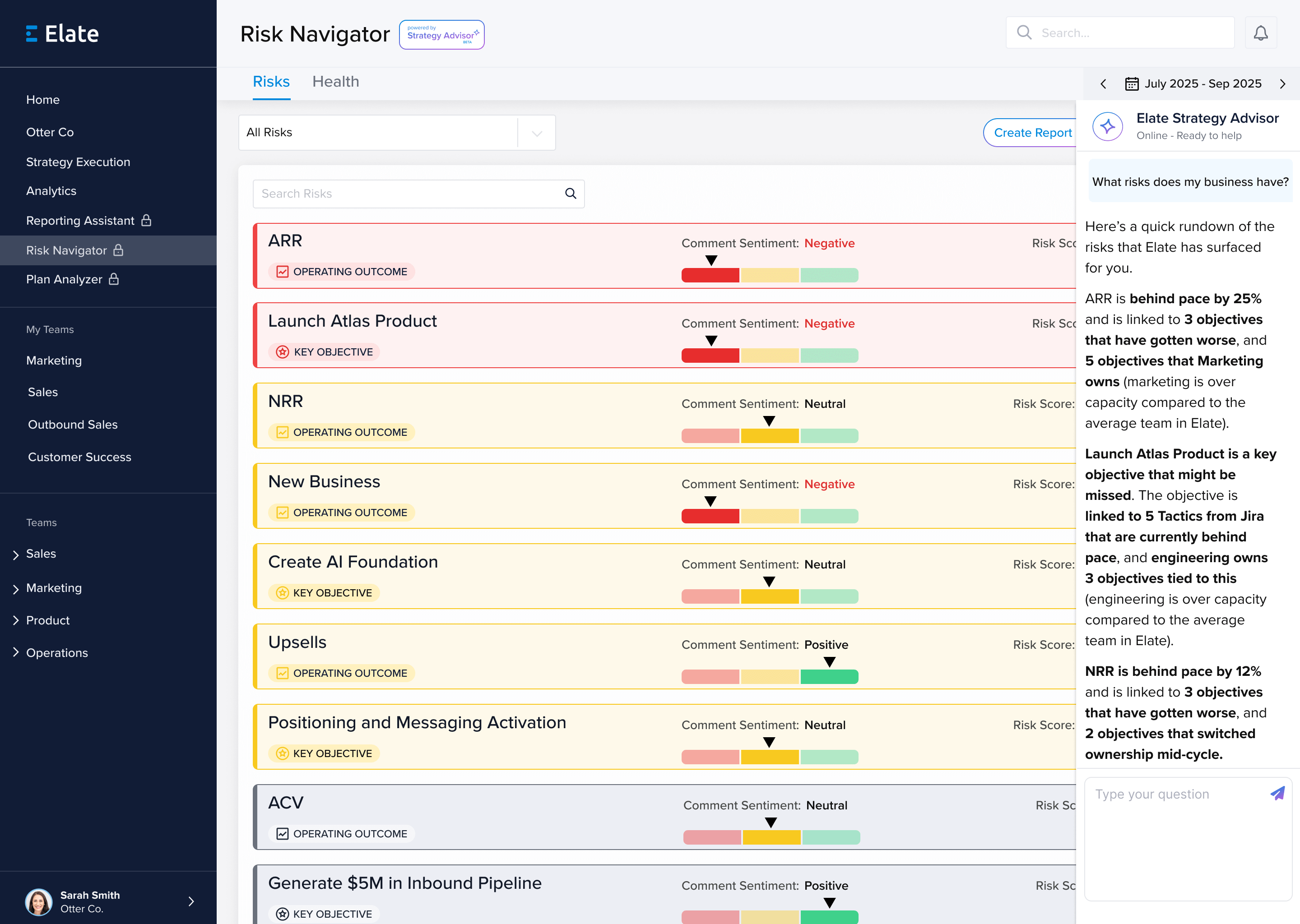The OKR methodology involves measuring and verifying progress on objectives that tie into strategic organizational goals. In the OKR methodology, there is always a clear indication of whether an objective has been achieved. Ideally, each key result will have a numeric indicator, such as, “Add 1,000 active users to the beta version of our software in the next month” in order to clearly define success.
For most objectives, organizations start with three key results to measure success for the desired outcome. While you can increase the number of key results, three to five usually is the sweet spot for setting specific goals that can be achieved for a given objective.
OKRs create statements of intent for different teams or departments. It's a way to disclose who is working on what across your teams, and ensure your company is aligned. Company level OKRs set the overall vision for what each department, team, and individual will work on during the quarter, and outline how those individual objectives contribute to the overall vision for the company. It’s important to start with company OKRs that are clear enough to provide an overarching direction for teams to ensure they are always working towards company objectives for growth and development.
OKR Checklist
An OKR checklist is a series of objectives with three or more underlying key requirements to meet the stated objective. Most organizations build their company objectives first, allowing departments to set goals for their teams that support the overarching framework of the company’s objectives. Individuals can break down departmental objectives into personal objectives and key results. This method puts a laser focus on results and keeps people tightly connected with goals the company sets for growth, profitability and development.
OKR Training
Setting up OKR training for your leaders and staff members helps everyone become familiar with the OKR model. Google, Trivago and other large companies already use OKRs to successfully meet their company goals. This means there is plenty of information available on creating your own training program or leveraging a software platform, like Elate, to customize your training and implementation of an OKR methodology. But keep in mind that every framework should be tailored to the business. It isn’t necessarily one size fits all, and we will be the first to share that the OKR structure should be modified to the stage and size of your business.
When you train employees to set objectives and key results, emphasize the importance of measurability and aligning goals to company objectives.
Tips for Establishing Executive OKRs
To begin your journey, you should start your OKR checklist with the executive team. Use your company's mission and vision to develop strategic goals that different departments and individuals can tie into. Starting at the top lets you work out the kinks before rolling out the framework to other levels of the organization. Remember that you will need to establish buy-in if you expect employees to fully commit to this line of managing all levels of activity.
OKR Framework
Objectives and key results (OKR) is a framework that helps organizations define objectives and track progress. OKRs first appeared on the scene in the 1970s, and were conceived by Andy Grove. Google, LinkedIn, Airbnb and Uber use this methodology to define and execute on their corporate strategy.
OKR vs KPI
One common misconception is that OKRs and KPIs are the same thing or even that you can’t use one without the other. In fact, we often see companies building a framework that includes both sets of measurables.
For a brief intro, KPIs are key performance indicators, which are similar to OKRs except that they focus on specific metrics tied to the health of the business rather than the objectives and key results from a top-down approach. Both KPIs and OKRs focus on performance indicators, but OKRs are more connected to company goals and interdependencies within the business.
Just because you implement OKRs doesn't mean you have to give up the meaningful KPIs that work for your company. Just remember that OKRs tie into overall business goals and objectives, and also help you from getting lost in paralysis by analysis.
OKR Weekly Report
When building OKR weekly reports, this process shouldn’t be manual, and it shouldn’t be reactive. It’s important that you find ways to streamline this process in a way that isn’t too manual or cumbersome for team members, and also allow for the weekly report to surface meaningful conversation to help prevent objectives from going off track.
So often weekly reports or leadership meetings can be derailed by conversation that isn’t centred on what matters for your business. It’s crucial that you establish a clear cadence and rhythm for how your reporting on objectives and driving meaningful conversation.
OKR Examples
Having OKR examples can help you set your own objectives and key results. Here, we provide real OKR examples to help you implement your own objectives for management and departments.
The goals for underlying teams all stem from the top and cascade down to individuals. Take the time to set company OKRs that will allow your managers and employees to create their own objectives and key results.
For example, a software company might have an objective to “Book $2 million in ARR this quarter.” The key results to reach that objective might include, 1) “Close 100 accounts with an ACV of $20,000 by December 31st.” 2) “Generate 500 qualified leads by October 31st.” and 3) “ maintain an average of three business days for legal review.”
OKR Review Meeting
An OKR review meeting is one of the most important events that take place within the OKR framework. These weekly meetings support goal setting and accountability. By reviewing progress in quick meetings at the team or company level, you can really see where your OKR system is succeeding or failing.
OKR Check-In Process
OKR check-ins often occur weekly, but can vary based on the stage of the company and needs of your team. In the weekly review meetings, it’s important to review changes to the overall status and trends surfacing in the key results. We also encourage a format for setting topics prior to the meeting to make the best use of time, and action items that are tied to priorities across the business.
OKR Meeting Cadence
All OKR meetings are meant to focus on the objectives of the business or key topics impacting the company goals. Company and departmental meetings often fall into the trap of going through the motions, and not focusing the time and effort on what’s important.
Quarterly meetings should be used to set strategic quarterly objectives for the entire organization that tie into annual objectives. Once those are set at the leadership team level, departments can then structure their OKRs accordingly. In weekly meetings, it's a good idea to focus on operational issues that provide barriers to reaching your objectives and key results. Daily meetings should be purely tactical and may include short brainstorming sessions to help overcome different barriers to meeting objectives.
OKR Review Template
OKR review templates consist of a series of objectives and their underlying key results. During each update period (daily, weekly, or quarterly), employees and leaders update the percentage completion for each KR and the objective as a whole. Obviously, this involves some subjective judgment, but should stay focused on the objective results when possible. Quantifying results helps every team member assess their progress and adjust their work commitments appropriately.
Building OKR templates in Excel, Word or free OKR software tools, may help you get started, but will often quickly be outgrown by companies as they continue to scale. Instead, it’s important to focus on selecting an strategic planning platform that connects your long-term strategic vision with the execution of objectives across every layer of the business.
OKR Quarterly Review
During an OKR quarterly review, it's important to present findings at the departmental levels before rolling them up to a progress report at the company level. After all, it's hard to know whether the company is meaning its objectives if all individuals and teams aren’t updating their OKRs.
An OKR action plan should follow the quarterly review to help the company and all levels of the organization realign their objectives and key results.
During the quarterly review, all levels of the organization should have an open and honest conversation about the feasibility of objectives and key results. Sharing constructive feedback between departments can provide a respectful way to help departments ask themselves the right questions and get back on track.
Conducting Team OKR Reviews
Teams have to review and analyze their own progress to identify why companies exceed objectives or fail to meet their goals. This is where so much of the detail of how the business is performing lives. While conducting a review on the team level, it's important to give everyone time to analyze and share their observations on successes and failures.
Team OKRs should have two results. First, a report of ideas, learnings and observations should be included. Additionally, you’ll need a short synopsis that can help others determine the progress of individual teams.
In summary, each team should prepare three main points to include in review of the company level OKR that their team contributed towards. After each team has given its own review, the CEO and other members of leadership should share results with the entire company. In addition to showing appreciation for goals that various teams have met, the review should point out room for opportunity.
As part of the action plan for the quarterly OKR review, leaders and managers should set new goals for department and individual employees, based on lessons learned. A monthly OKR tracking template might be a good start, but again won’t help your company proactively identify areas of opportunity. This is where a platform like Elate comes into play.
OKR Tracking Tools
When looking for the best OKR solution for your company’s OKR strategy, it's important to evaluate a solution that will scale with you.
Elate was built to serve high-growth companies looking to scale their teams and create alignment.
At Elate, our belief is that OKR tracking tools don't have to be complicated, but they have to be tailored towards your business. In fact, the more intuitive that you make the tracking tools you rollout across your teams, the more adoption you will see across the business. Making it easy for employees to create their own objectives and key requirements to feed into the company's business goals will drive buy-in and support from the onset.
From an OKR check-in template to the overall framework for how your company builds your strategic plan, Elate is built to create a cadence that works for your company.
Contact Elate today to find out the best way to implement OKRs at your company!











